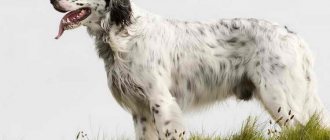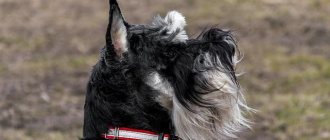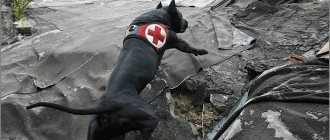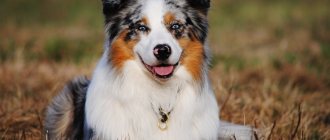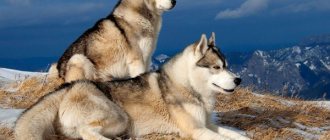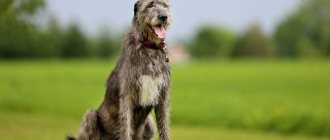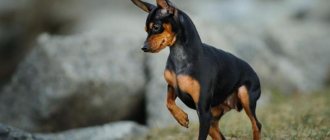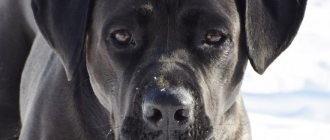Story
As the name of the breed suggests, large white dogs first appeared in the Pyrenees Mountains, where they worked as shepherds, protecting flocks of sheep from predators. Excavations show that such dogs appeared 6-8 thousand years ago in Asia. There is no reliable and accurate data on where large white dogs came from, but there is information that suggests that the ancestor of the breed was the white Tibetan mastiff. Along with the Great Migration of Peoples, the faithful defenders ended up in Europe, where they quickly gained popularity not only among shepherds.
In addition to its main functions, this breed was used for smuggling purposes. Thanks to their intelligence and endurance, wolfhounds easily crossed the border between Spain and France in places where humans could not pass.
The Pyrenees Mountain Dog first appeared at the European court during the time of Louis XIV, who in 1675 proclaimed them court servants, as stated in the chronicles. In addition, it is documented that it was precisely such a dog that saved Charles V when the king was attacked by an angry boar.
In the XVII-XVIII, huge white dogs became popular in France, which exported them to other European countries, for example, Italy and England.
The first registered Pyrenean wolfhounds entered the exhibition only in 1885. The breed standard was approved in 1907.
During the two World Wars, the Pyrenean mountain dog almost became extinct . People did not have the opportunity to keep such large dogs. Thus, the world almost lost this most beautiful breed. But a group of French enthusiasts, having searched all the Pyrenees mountains, managed to find several dogs that fit the breed standard and in 1960, the breed was again officially recognized.
The Great Pyrenees Mountain Dog was originally bred to guard flocks and successfully cope with its duties. French nobles used them as guards or for hunting big game. In the modern world, these dogs have almost lost their working skills, since they are rarely used for their original herding purpose. But even now they are excellent guards and just kind and fluffy pets.
Character and psychological portrait
The Pyrenean Mountain Dog combines strength, extraordinary intelligence, boundless devotion to the family and an innate protective instinct. This is a reliable, affectionate and obedient companion that inspires respect like a watchdog and admiration like a pet.
Adult Pyrenean dogs are calm by nature and love a quiet, serene environment. They like life to be consistent and predictable. They are not suitable for an apartment or private house with a small yard within the city, where there is a lot of noise and bustle. They will be happy to live in the company of their fellows. Like many other guard dogs, Pyrenean dogs bark a lot, especially at night. They are very smart and independent, sometimes stubborn and independent like a cat. Reviews about Pyrenean dogs are more like odes of praise.
The Pyrenees Mountain Dog is a serious working breed; it will not be a companion for active recreation and will not look into the eyes, waiting for a command, nor will it carry it out with lightning speed and unconditionally. They are obedient only when it comes to business and will not waste energy. Mountain dogs can be trained quite well, but they must first be interested and “stirred up.” It is advisable to spend time every day repeating and consolidating commands.
Purpose and performance qualities
The Great Pyrenees is a guard dog by nature with strong territoriality. Their main task is to protect the herd, and not to drive or gather cattle. Shepherds may, due to duty, not observe their assistants, who at this time independently walk around the property. Dogs are active both day and night.
The Pyrenees Mountain Dog is a living example of the fact that a watchdog can become a real decoration of the site and does not necessarily have to be vicious or aggressive.
Helpers on a farm or ranch live quietly among other animals while performing their guard duties. Such dogs do not live in a house and do not need close proximity or command from a person, only daily interaction. At the same time, the dog can independently expand the protected territory and protect the property of adjacent neighbors. Unlike SAO or Caucasians, Pyrenean dogs do not immediately rush to attack. First they growl and bark loudly, then they will try to push the stranger towards the exit, biting his legs; if this does not help, then they will resort to using their teeth.
Description of the breed
The Pyrenean mountain dog, with its appearance, can extremely amaze a person who has never seen such animals before. A majestic, stately, large dog with beautiful white fur looks like a polar bear. Cynologists classify such dogs as the so-called Molossian type, which also includes mastiffs and Great Danes.
The coat color of Pyrenean mountain dogs is usually white. Gray or fawn spots are allowed. The most valuable are dogs with a badger “mask” on their muzzle . According to conformation standards, the total area of spots on the coat should not exceed one third of the total surface of the coat.
The same mask
The undercoat is thick. The coat is long and straight. Short on the head, long on the tail, mane, collar and pants. The fur is close to the body. The most abundant covering on the neck forms the so-called mane. A raised or wavy coat is considered a fault in conformation.
Breed standard:
- The dog's head is not large compared to the body, it looks elegant and noble. The shape of the skull is correct, the muzzle itself is wide. The lips and lobe are black, contrasting beautifully with the white color of the coat. The jaws are powerful, with a scissor bite (the upper lip slightly overlaps the lower lip). Number of teeth 42.
- Breeders especially highlight the dog's eyes. As experienced dog handlers say, if a dog’s gaze is not spiritual, then such a dog cannot be considered a Pyrenean mountain dog . The look, combined with a “smile,” creates a unique facial expression, characteristic only of this breed. The eyes of the Pyrenean Wolfhound are amber-brown, almond-shaped, slightly slanted.
- The ears are triangular, medium size, hanging, rounded. Their fur is shortened.
- The neck is muscular, not short, but not long either. The scruff is well defined.
- The body is elongated with a wide chest and a well-developed muscular back. The back is long and strong.
- The tail is set low. Covered with thick long hair. When walking or running, the dog usually does not lift it high.
- The paws are straight, parallel to each other. The muscles of the limbs are well developed. The fingers are closed, the pads are dense. The dog has not five, but six toes on its hind legs. These two thumbs, higher than the rest, at one time served as a kind of “crampons” to make it easier to walk in the mountains.
An adult male Pyrenean wolfhound weighs about 60 kg and reaches a height at the withers of up to 80 cm. For a female, the norm is 55 kg and a height of 65-72 cm.
The Great Pyrenees Mountain Dog barks a lot. This is a feature of guard dogs. They bark at everything and especially at night.
IMPORTANT! Their bark is very loud and ringing, as befits a good watchman.
Therefore, if a person is not ready for this, it is better to think about purchasing another breed of dog.
History of the Pyrenean Mountain Dog breed
The genetic roots of the Pyrenean mountain dogs have been lost in the darkness of centuries, so it is not possible to establish their relationship with existing and extinct breeds.
According to one version, the ancestors of snow-white dogs were Tibetan Molosser-like dogs, which from ancient times were crossed with local sires in the French part of the Pyrenees. The breeding experiments were carried out mainly by shepherds, who needed massive, sensitive animals capable of driving away hungry predators from their sheep, or even entering into confrontation with them, so the character of the ancestors of the Pyrenees was Nordic, and their habits were ferocious. Mentions of the breed in printed sources date back to the 14th century. One of the first descriptions of the appearance of Pyrenean mountain dogs belongs to the abbot of a French monastery, Miguel Agustin, who at the same time explained why medieval breeders preferred individuals with white hair. According to the monk, the snow-white color helped the shepherd not to confuse the dog with a wolf. In addition, it was easier to find dogs with light hair if, carried away by the pursuit of predators, they strayed from the herd and got lost in the valleys.
By the end of the 17th century, the Great Pyrenees moved away from herding duties and began to guard feudal castles, which was facilitated by the increased PR of Madame de Maintenon’s breed. It was the favorite of Louis XIV who was the first to bring amusing Pyrenean mountain dog puppies to Versailles, which charmed the entire palace nobility, including the young Dauphin. In the 19th century, the population of predators in the mountainous regions of France declined, and the chambers of nobles no longer needed four-legged guards, so the need for the services of working dogs disappeared. However, the Pyrenees were not taken by surprise by such transformations, since by that time they had successfully mastered a new niche - dog shows.
Before the preliminary standardization of the breed in 1923, its representatives were divided into two types: Western and Eastern. Westerners were distinguished by a distinctly Molossian appearance: they had large heads with drooping lips and rounded ears, as well as sparse wavy fur of white or black color. Dogs from the eastern regions of the Pyrenees looked more intelligent than their relatives in the group. The animals' muzzles were elongated and pointed, like their ears, and their soft, thick fur was a solid snow-white color. In the early 1930s, Pyrenean mountain dogs began to be bred in the United States, and in 1933 the breed was registered by the American Kennel Club.
An interesting fact: in modern representatives of the Leonberger breed, along with the genes of St. Bernards and Newfoundlands, the blood of Pyrenean mountain dogs flows.
Features and diseases
Pyrenees Mountain dogs are naturally strong and resilient. They were bred to herd flocks and live in difficult conditions. Therefore, their health is excellent. Although there is, of course, the possibility of diseases:
- One of the few problems common to most large, heavy dogs is limb dysplasia . Therefore, the dog’s elbow and knee joints should be under special control by a veterinarian.
- Thick undercoat and coat can create certain skin problems if the dog lives in a hot climate.
- Pyrenees do not like confined spaces and can become seriously ill if they stay in a small room for a long time. They require a large area to live in, where they can have plenty of fun every day.
- This breed of dog has ears that fit tightly to the head, as a result of which they do not receive the required amount of ventilation, which leads to the development of serious ear diseases, in particular, otitis media . The disease will begin to manifest itself with the appearance of an unpleasant odor from the ears.
Disgusting odor from dog's ears: quick cure strategy
How to choose a puppy
A Pyrenees Mountain Dog litter contains 4 to 7 puppies. Childbirth in bitches is easy, and outside intervention is rarely required, but in the first days, breeders closely monitor the breeder - sometimes large mothers are able to crush a baby or two as a result of a careless turn.
- When going to the nursery to meet the puppy, ask the seller to show the entire litter. If there are no fundamental differences between the size and build of the babies, this indicates the high quality of the offspring.
- Check out the legs of a Pyrenean mountain puppy. Look at the animal in stance and movement, pay attention to the position of the limbs (they should be parallel to each other) and the presence of dewclaws - there should be two of them on each hind leg.
- Fluffy “caps” on the puppies’ heads and large ears are normal phenomena for the breed. With age, the fluff on the head of a Pyrenees disappears, and the ears no longer look like “burdocks” against the backdrop of a body that has gained weight.
- Ask the breeder to weigh the Pyrenees you like. At two months, an exemplary baby should weigh at least 7 kg, and at three months, about 14-19 kg.
- Look for a nursery that specializes in suburban growing. Pyrenees mountain dogs bred in cramped apartments are almost always unhealthy, rickety and mentally unstable individuals.
- Take a closer look at how the kids communicate with the breeder. If they willingly come up for affection and don't squeal when picked up, this is a good sign. This means that the animals have a balanced psyche, and the owner treats his charges correctly.
- The puppy's coat should be thick and fluffy from the first days of life. Do not believe the seller’s promises that as the Pyrenees with sparse fur grows up, it will “increase” the required amount of shaggyness. This definitely won't happen.
- Study the pedigrees of the sires and find out whether they have been tested for dysplasia - serious nurseries do not skimp on veterinary examinations.
Where is the best place to buy a puppy: nurseries
When choosing a puppy, you should pay attention to how the puppies look, how well-groomed they are and how happy they are with life. You need to take a closer look at the face; if there is no Pyrenean expression on it, most likely it is a non-purebred representative of the breed.
You should try not to purchase puppies from breeders who breed wolfhounds in apartments. This is unacceptable for this breed.
The most famous nurseries in Russia are:
- "Zurion";
- "Nicoloberg";
- "YAKOGOR".
Pyrenean mountain dog price
In Russia, the breed is not represented as widely as in the USA or European countries, so you will have to spend time searching for a reliable nursery. The lack of prevalence of the Pyrenees also affects their price tag. For example, buying a puppy with a pure pedigree and no developmental defects will cost 50,000 – 60,000 rubles. Offspring born from a foreign sire will cost an order of magnitude more - the seller will not forget to take into account the costs of travel to another country and the time spent. Owners of well-promoted foreign nurseries are very reluctant to agree to breed their pets with Russian Pyrenees. Individuals with mediocre ancestors, defects in appearance and those who have not been examined for genetic diseases can be purchased cheaper - around 30,000 - 35,000 rubles, but in this case there is a high risk of going broke on treatment from a veterinarian.
Owner reviews
Olga:
Our favorite Dick is already two years old. He's part of the family. A beautiful, smart and kind dog. Children especially dote on her. They can all play together for days. I don’t regret at all that we have such a miracle in our family.
Stanislav:
I live in the village and adopted a dog to guard my property. He copes with his duties perfectly. Because of the menacing barking, they avoid strangers, but with close people, this is a kind-hearted dog.
Inna:
Our Margot is the best dog in the world. Very cheerful and sociable. I don’t worry about the children when they walk with Margosha, I know for sure that he will protect and will not give offense. Great dog!
Dmitriy:
A wonderful dog, funny and smart. He understands everything perfectly. I had to work a little while training, but it was worth it. The dog gets along well with all family members and has never shown aggression towards anyone in three years.
Characteristics: pros and cons
The Great Pyrenees Mountain Dog is the epitome of nobility, intelligence and fearlessness. They are balanced and absolutely not aggressive, and have absolutely no fighting qualities.
- Dogs begin to show their character as early as four months. It is during this period that the owner needs a certain firmness. It is very important that the owner is an authority for her, otherwise she will not listen.
- Dogs of this breed are very loyal to their owners and their loved ones . They have no problems with other pets, including cats.
- These large, beautiful wolfhounds take everyone who lives with them under their protection. When communicating with “strangers,” they may well growl, show their teeth, or bark strongly if they seem to have some kind of malicious intent. It is this character trait that makes them excellent watchmen and security guards.
- Among the disadvantages, it should be noted that due to its free-thinking, a dog that is not kept behind a high fence or on a leash can easily run away . Representatives of this breed think independently and consider everything as far as they can see to be their territory. These features are due to the fact that initially they were shepherds.
- It should be noted that the Pyrenean Wolfhound sheds very heavily . All the time. Hair from this dog will be everywhere, especially if you keep it in an apartment.
- Despite their rather sociable character, such dogs can easily tolerate prolonged loneliness and will never impose their company.
Children's faithful friend
Despite all their majesty and noble appearance, these are very restless dogs . They are never averse to frolicking and playing. They are very lenient towards children and are able to be patient with any children's pranks. The Iberian Wolfhound is usually very affectionate and kind. It is widely accepted that the Great Pyrenees Mountain Dog is an excellent pet candidate for families with children.
Personality of the Pyrenean Mountain Dog
Today's representatives of the breed are no longer shepherds of “lost sheep souls,” although documented they continue to be working dogs with an excellently developed protective instinct. The modern generation of Pyrenees are intelligent and sensitive companions and watchmen who view the human family as their own pack, which allows the animals to quickly and without unnecessary stress accept the rules of the game dictated by the owner. And shaggy giants love close physical contact, so if you are looking for a pet that is ready not only to endure your and children’s hugs, but also to be truly delighted by them, then the Pyrenees Mountain Dog is the animal you need.
Despite their distinctly brutal appearance, the Pyrenees are among the breeds with a reduced level of aggression. This means that this “blonde” is able to scare half to death a fox or ferret that has dropped into your yard, but he will not adhere to the same tactics in relation to two-legged troublemakers. At the same time, the breed does not favor strangers, which is understandable. Since ancient times, suspicious individuals hovered around sheepfolds, ready to kidnap a well-fed lamb, so the animal’s task was to confront such lovers of free roast.
Pyrenean mountain dogs are extremely child-loving, so they will not stoop to conflict with some toddler, even if the latter clearly abuses the dog’s good nature. Moreover, if the young mischief-maker is in danger from another animal or person, the shaggy “guardian” will immediately react to this. Another feature of the breed is a hypertrophied territorial instinct, thanks to which the pet considers as its own territory not only the house in which it lives, but also locations where it is noted from time to time, for example, a public garden where the owner walks it. Therefore, if the Pyrenean mountain dog does not sleep or dine, it is almost certainly patrolling the domains entrusted to it, looking out for encroachers on the owner’s wealth.
The possessive habits and territorial claims of the Great Pyrenees in no way infringe on the rights and freedoms of other domestic animals. The breed is not averse to sharing its habitat with cats, other dogs, and especially artiodactyls, which so need a powerful protector. Even if you are a big fan of hamsters and other miniature furry creatures, you don’t have to worry about their life and health. It would never occur to a Pyrenean mountain dog to catch and eat even a rodent that was asking for it. But shaggy giants are capable of accidentally stepping with their massive paw on a gaping tiny lump, so be extremely vigilant when allowing a hamster to walk around under the feet of a larger pet.
Conditions of detention
If you have decided to buy a Great Pyrenees puppy, you need to pay attention to the fact that this dog is not at all suitable for living in a city apartment. A small enclosure and a chain will not suit her either. This freedom-loving and active animal should only be kept in a country house with a garden area. Any other types of maintenance will quickly lead to the dog wasting away and getting sick a lot.
IMPORTANT! It is not recommended to keep your pet on a leash. It is necessary to build a spacious enclosure with a booth where the dog can be left overnight. Any tight conditions have a bad effect on the health and appearance of the pet.
Comfortable enclosures for dogs: do it yourself without waste or mistakes
If the owner walks the dog on a leash, then when accustoming the puppy to it, you should remember that they will get used to the leash less painfully if you distract the baby with treats. From the very first days, you should teach your dog to walk on a loose leash and not allow him to play with it or chew on it.
Walks should be active and long, as this type of dog loves a free lifestyle.
Health and life expectancy
Pyrenees are large, hardy and strong animals with good immunity. Unfortunately, it cannot be said that the breed is completely free of hereditary diseases. Among the most common are:
- Hip dysplasia;
- Eczema;
- Diseases of the musculoskeletal system.
Under good conditions, the Pyrenees live 10-12 years.
Necessary care
Caring for this pet includes several points.
Feeding
To understand how a dog should eat properly, you should remember that they are all predators. Their teeth and fangs are designed to tear meat and gnaw bones, and a wide esophagus and concentrated gastric juice serve to facilitate the digestion of large pieces. When planning your diet, you need to take these features into account.
- The majority, approximately two-thirds, of the food consumed by the dog should be protein foods . This includes lean meat and offal, cottage cheese, eggs and fatty fish. Raw tripe is extremely useful. All these products are best given raw; the meat can sometimes be boiled.
- The rest of the diet should consist of a variety of fruits and vegetables . They are also recommended to be given raw. Under the influence of coarse fiber, the correct microflora is formed in the dog’s intestines; boiled vegetables will be useless.
- Porridge has virtually no benefits for dogs. Only carbohydrates are digested from cereals, which contribute to the accumulation of fats. Therefore, if they are given to a wolfhound, then only in winter, when additional energy is required. The norm for a representative of this breed will be no more than one glass per week. Read more: Tips and recipes from experienced dog handlers: porridge for dogs
- vitamin and mineral complexes to your dog's diet , which can be purchased at any veterinary pharmacy. Before introducing vitamins, you should read the instructions or consult a veterinarian.
- In addition, it is good to add 2 tablespoons of vegetable oil or 100 grams to your diet daily. oily fish . This is a good source of polyunsaturated fatty acids for any organism.
- Breeders also recommend adding 2-3 tablets of brewer's yeast, a tablespoon of bran and half a teaspoon of fish oil to the diet of a puppy and an adult dog every day. And a couple of times a week you should treat your pet with beekeeping products.
- The dog should not be overfed. The puppy should look underfed rather than fat ( Cerberus diet depending on age: what should you feed your puppy? ). Under the influence of excess weight, the dog may develop disorders in the paw ligaments and problems with the spine. To prevent your dog from overeating, it is necessary to remove the bowl out of reach of it immediately after it has had enough. Usually 10-15 minutes are enough for this.
- The amount of food depends on the activity and place of residence of the dog. Moreover, in winter she needs almost twice as much food to maintain her energy at the proper level.
- If it is not possible to feed your pet natural products, you should choose only premium dry food. For example, .
- The bowls from which the dog eats should be no lower than chest level. To do this, it is recommended to purchase special stands in the store.
Hygienic grooming
The coat of the Great Pyrenees Mountain Dog requires the most careful care from the owner. It must be combed at least 3 times a week , otherwise tangles that can only be trimmed.
Despite the fact that the coat of the Pyrenean wolfhound is white, it does not get dirty very often. It is recommended to wash such dogs no more than four times a year.
IMPORTANT! Pyrenean mountain dogs cannot be groomed. After this procedure, problems with skin and parasites are possible.
Particular attention should be paid to your pet's ears . They must be cleaned with cotton pads or swabs, which are moistened in special solutions.
Without pain and whims: detailed instructions on how to clean a dog’s ears
Health
Like any other dog breed, the Pyrenees Mountain Dog is prone to certain diseases:
- gastric volvulus;
- eye diseases;
- dysplasia of the hip and elbow joints.
Preventative measures to protect your Pyrenean mountain dog puppy
- To keep your Pyrenean Mountain Dog puppy completely safe, you first need to minimize his contact with unfamiliar dogs, especially strays. Therefore, you should not let your dog off the leash, as in this case it will become impossible to control its behavior and communication with other dogs. Since a dog can easily become infected with distemper from simply touching the nose of a sick animal. This disease can be transmitted to a dog through sniffing. Your dog can become infected with trichophytosis from contact with the lichen-affected fur of a sick dog. Naturally, it is impossible to completely exclude a dog’s communication with other dogs, since it must be socialized. Therefore, try to find friends with dog lovers who look after their animals. By adhering to this rule, you can eliminate the risk of pathogen transmission by 80%.
- You should walk your dog in places where there are no landfills. Since garbage very often attracts rodents, which in turn are very often carriers of various infections. Gray rats are especially dangerous because they carry such a serious disease as leptospirosis.
- You should not allow your dog to sniff other people's feces, as they are a source of worms.
- Monitor the well-being of your Pyrenees Mountain Dog. Pay attention to even the most minor changes in his behavior. For example, your dog may appear lethargic, lose his appetite, or have a dry nose. Or you may notice that the dog begins to shed, and this has nothing to do with seasonal shedding. If hair loss becomes excessive, this is the first symptom indicating health problems in your pet. And only you can help him. Therefore, it is important to take the dog to the veterinary clinic in time, where the disease can be overcome for sure. In no case should you ignore the symptoms, since advanced infections are much more difficult to treat, and sometimes even impossible. If you start treating your dog, the disease can lead to his death or he will develop serious complications that will affect his hearing, vision, limbs and much more.
Training and education
Pyrenean mountain dogs are distinguished by their rare intelligence, they easily understand and remember commands, but due to their wayward and freedom-loving nature, they can become very stubborn. They can easily sense weaknesses in character, so if you are unsure of yourself, it is better to entrust training to professionals.
Training of the breed begins when the puppy is three to four months old. The list of mandatory commands includes “Sit”, “Lie down”, “Come to me!”, “Ugh”. The dog must unquestioningly respond to its name.
Training of this breed of dog can be carried out in several training courses:
- UGS – controlled city dog;
- OKD – general training course;
- VN is a companion dog.
After the dog completes the course and passes the exams, its owner is given a special diploma.
Character
The Pyrenean Mountain Dog is endlessly devoted to its family. She loves a calm, measured lifestyle. She has a friendly disposition; unjustified, excessive aggression is not inherent in her.
In the right situation, the Pyrenees will show both severity and fearlessness. He has a keen sense of his own territory. The guard instinct is highly developed from birth.
Treats children kindly. But due to the fact that the Pyrenees is a large, heavy dog, it is impossible to leave him alone with preschoolers and children of primary school age.
Without meaning to, in the excitement of the game he may push the child or step on it with his paw. There must be adult supervision.
Strangers will never become friends of a Pyrenees. He is always loyal only to his family and will never trust strangers. You should not try to pet him, so as not to provoke aggression.
He gets along well with pets and can easily live in the same area with both cats and rodents. But on the condition that no one challenges his leadership. Also, the Pyrenees will not allow anyone other than its owner to approach its bowl of food.
Nicknames for boys and girls
The choice of nickname should be approached very seriously. It should be simple, easy to remember and easy to pronounce. In addition, it should not be in tune with the main commands. You should not call the puppy with diminutive forms of his name until he gets used to responding to the full name.
Nickname options for boys:
- Camlet;
- Onyx;
- Aslan;
- Top;
- Teddy;
- Laurel;
- Lucas;
- Loki;
- Zach;
- Kurt;
- Hail;
- Zakhar;
- Dollar;
- Amethyst;
- Ernie;
- Bear.
The most amazing feature of this dog breed: it is a constant, slightly sly smile that does not leave its muzzle.
Options for nicknames for girls:
- Delia;
- Nessie;
- Lady;
- Teffi;
- Dory;
- Terra;
- Xena;
- Lussy;
- Cassie;
- Sakura;
- Snowball;
- Helly;
- Bella;
- Naiza;
- Shari;
- Audrey.
Differences with the Maremma Abruzzese Sheepdog
The Great Pyrenees Mountain Dog and the Maremma Abruzzese Sheepdog are quite similar to each other. They were bred to perform the same function - protecting herds and flocks of sheep on the slopes of the mountains.
Maremma / Pyrenees
Abruzzese Shepherd/Great Mountain Dog
They differ in the shape of the head and the shape of the body. In addition, the Pyrenees Mountain Dog has an unusual facial expression, unique to this breed, which is difficult to confuse with anything else.
By nature, both of these dogs are very friendly, responsible and quite headstrong. Maremmas are easier to train.
The following differences are also distinguished between these dog breeds:
- The Maremma has high-set ears, while the Pyrenees have drooping ears;
- Maremma does not show aggression even towards strangers who visit the home, until they begin to transgress the bounds of decency, but the Pyrenees can sometimes growl at strangers;
- Maremma is a rather heat-loving animal, which cannot be said about the Pyrenees, who can tolerate significant cold.
Purpose of the breed
Pyrenean mountain dogs have been used since ancient times to protect and accompany herds. Sometimes they, without the participation of the owner, had to drive flocks between pastures across the mountain ranges for several days. The owners easily entrusted this work to the dogs, knowing their ability to quickly react and make independent decisions in case of danger.
Due to their size, the Pyrenees could even withstand predators such as bears. And their color helped them not to stand out among the herd. Dogs of this breed were also used as traction dogs, helping their owners transport carts with cargo.
During the war, Pyrenean dogs established themselves as paramedics who found the wounded and pulled them from the battlefield. They also served as messengers and postmen, delivering small cargo through the mountains. Some smugglers are now using this quality for their own purposes.
Nowadays, as before, these dogs serve as excellent territorial guards and defenders. This breed can be found in boarding schools for children with developmental delays, where the Pyrenees work as four-legged psychologists.
But most often this breed is adopted as a shaggy friend and devoted companion, who can also be a gentle, caring nanny.
Movie
If you want to watch a movie about a Pyrenees mountain dog, it is recommended to watch the movie “Belle and Sebastian”. This is the first part of a trilogy, the films “Belle and Sebastian: The Adventure Continues” and “Belle and Sebastian: The Final Chapter” will also be released.
The films tell about the true friendship between the formidable Pyrenean wolfhound and a simple boy Sebastian, describing their adventures.
In addition, you can watch a lot of videos dedicated to training or raising this breed of dog.
Photo
Let's enjoy a variety of Great Pyrenees dogs and their puppies:
Eh, make way, honest people!
What are you watching? I didn't do it!
Characters of the feature film - Belle and Sebastian
Well, how can you not smile when looking at this pie?
The shepherd is not just for the sheep
The first dance with the owner is exciting!
We're lying down well, aren't we, goat?
